
By default, Python will try and retain the resource for as long as possible, even when we’re done using it.īecause of this, we can close the file by using the. Python must be explicitly told to manage the external resources we pass in. At this, I’ll take a quick detour and discuss the importance of closing the file as well. When we run this, we’re opening the text file. Save the file and note its path into the file_path variable below: # Opening a text file in Pythonįile_path = '/Users/datagy/Desktop/sample_text.txt' Feel free to download this text file, if you want to follow along line by line. Ok, let’s see how we can open a file in Python. The different arguments for the mode= parameter in the Python open function Open for writing (appends to file if it exists) Open for exclusive creation (fails if file already exists)

Open for writing (first truncates the file) Let’s take a look at the various arguments this parameter takes: Character

This is controlled by the mode parameter.
#SEMAPHOR PYTHON TEXT FILE HOW TO#
When opening a file, we have a number of different options in terms of how to open the file. In this tutorial, we’ll focus on just three of the most important parameters: file=, mode=, and encoding=. Newline=None, # How to identify new linesĬlosefd=True, # Whether to keep file descriptor open Let’s take a look at this Python open function: open(Įncoding=None, # The encoding used for the fileĮrrors=None, # How encoding/decoding errors are handled This function, well, facilitates opening a file. Since we’re focusing on how to read a text file, let’s take a look at the Python open() function. Python provides a number of easy ways to create, read, and write files. How to Read a Text File in Python with Specific Encoding.How to Read a Text File in Python to a Dictionary.How to Read a Text File in Python to a List.



 0 kommentar(er)
0 kommentar(er)
